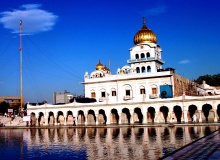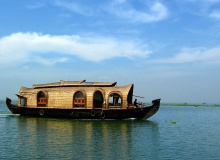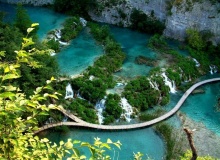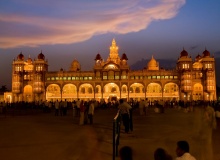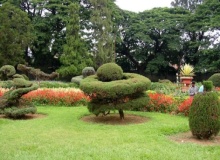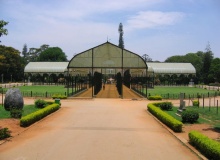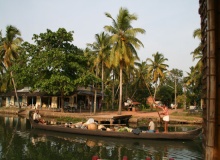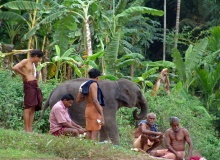India
Mumbai | Delhi | Bangalore | Kerala
A multi dimensional travel experience offering an intoxicating cultural cocktail for the visitor
Travel to India is an all-out assault on the senses. You'll travel through dusty heat (or snowy cold in the north), sharing roads with a parade of bicycles, auto-rickshaws, sputtering motorcycles, tinsel-draped trucks, camel carts and the occasional cow. At India's sites and markets, the chaos continues: throngs of beggars, hawkers, tourists, near-naked holy men, businesspeople, children and scurrying monkeys. Amid the cacophony, some of the globe's most majestic and historical sites will emerge—the Taj Mahal, the Ganges, the pink city of Jaipur and the mighty Himalayas.
India, with all its variety, offers a multi dimensional travel experience and an intoxicating cultural cocktail. As you travel from region to region, you'll be exposed to dramatic changes in cuisine, dress, language, religion, custom and tradition.
Some parts of the country are rife with modern conveniences, and Indians there live in fashionable real estate, surrounded by the trappings of 21st-century consumer capitalism. Malls, multiplexes and lifestyle stores are opening everywhere. Yet in some areas, people still don't have access to clean water, electricity, adequate food and medical care. Many people, attracted to cities in search of jobs, stay in clumsy shacks because of unaffordable real estate, resulting in slum regions. This is especially prevalent in India's commercial capital, Mumbai, where the government is building multi-storied housing complexes to accommodate these people.
With these contradictions come complications. The mass of humanity that populates India requires that you be patient, flexible and tolerant, which can be difficult if you're troubled by the disparities between India's rigid social classes. Most travellers will find these difficulties well worth the rewards, however as India remains an incomparable and unforgettable travel experience.
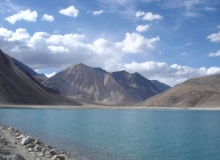

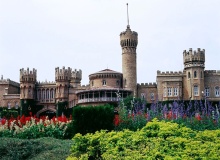
Mumbai
Travel Mumbai and experience a city of extreme contrasts, of great prosperity and abject poverty, of 21st-century technology and medieval squalor. Mumbai’s attractions include the finest collection of Victorian buildings found anywhere in Asia, Art Deco buildings, a myriad of temples and mosques, warrens of bazaars and markets, chic bars and the finest restaurants. Yet half of its population live in slums - the highest percentage for any large Indian city. Mumbai is also congested with people (it has a population of approximately 15 million, which is rising relentlessly) its streets are clogged with traffic, its air is foully polluted by the barely controlled emissions of its factories and vehicles, and many of its buildings are slowly crumbling. However, the city still has much to offer. Mumbai is a colourful (the saris, the bazaars, the Indian sunlight), vibrant, energetic and friendly city, with a varied and fascinating history, grand colonial relics, glistening towers and many reasons to face the future with confidence.
From its earliest days an important entry port, Mumbai today is the financial centre of India, home to the country’s largest stock exchange, the heart of its banking industry. It is an important centre of the gem trade and film industry - Bollywood - is a national institution. For many visitors, the city is only a point of arrival, a springboard for the south or the architectural glories of the north. But to pass through Mumbai without stopping a while is to miss one of the worlds great cities, as worthwhile and idiosyncratic as any on earth.
WHEN TO TRAVEL to Mumbai
The best time to travel Mumbai is between the months of September and April, when the weather is relatively dry and cool. To experience a big cultural event, make it Ganesh Chaturthi, an 11-day Hindu festival in August and September.
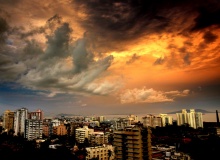
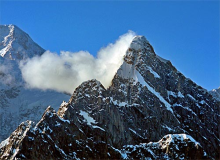
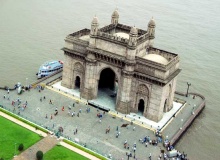
Delhi
Travel to Delhi is a daunting experience. It sprawls uncontrollably over a vast tract of the Jamuna plain, its population (13.8 million at the last count) is a seething mass of humanity and its poverty and pollution challenge the sensibilities and respiratory systems of even the most hardened travellers. Those who look beyond the squalor that envelops much of the city, the thundering traffic, the acrid smog and the constant demands of the hustlers will find delights at every turn - historical, architectural, floral and culinary - quite apart from the vivid colour, eastern eccentricity and restless vibrancy that give Delhi its spirit.
Modern Delhi is really two cities: Old Delhi, packed into the narrow streets beneath the dramatic Red Fort's imposing walls complete with its medieval bazaars and New Delhi, which is its polar opposite, complete with the grandiose Imperial citadel, chic bars and cafes, broad, leafy boulevards and well-spaced bungalows, as laid out by Lutyens and Baker in the 1920s.
As well as being a starting-point for visiting Agra, the home of the Taj Mahal, or the cities and forts of Rajasthan, Delhi itself has much to offer. The architectural legacy of the Islamic conquerors is rich and varied, the colonial centre is imposingly impressive; there are some interesting museums and the city’s bazaars and shops offer a bewildering array of goods, from spices and silks to car spare parts. The city’s restaurants tempt the visitor with a wide variety of delicious food, which by Western standards is mostly very reasonably priced.
WHEN TO TRAVEL to Delhi
The best time to travel to Delhi is November through February. Summer in Delhi is best avoided. From mid-April, the temperature rises inexorably. For much of May, June and July the thermometer is stuck at around 45C (113F), before the monsoon brings some relief.
_______________________________________________________________________________
Bangalore
If you want to have a preview of the future of India, head to Bangalore, a dynamic and mushrooming city in the centre of South India that has been energised by the explosion of information technology industries and colonised by homegrown entrepreneurs. With its youthful workforce, round-the-clock lifestyle and abundance of shopping malls, Bangalore is a walk-through peek at where the sub-continent is heading in the 21st century. This explosively expanding city lies 855 kms southeast of Mumbai and has an international airport for easy access from all parts of India.
Previously known for its public gardens and laid back pace of life, Bangalore is now a booming software industry centre. Plan at least one day to see the city adequately. The town is considerably more Westernized than many Indian cities. Visit Bangalore Palace, the Palace of Tippu Sultan, once home to the south Indian king famous for battling the British, the Bull Temple, the Indian Institute of Science and the 100-hectare Lal Bagh botanical garden, with its pools, terraces, fountains, trees and herbs.
However the city's infrastructure has not yet caught up with the fast growth of the city. This is especially felt while driving. Nearby Bannergatta National Park makes for an interesting day trip to watch Indian animals in their natural habitat.
WHEN TO TRAVEL to Bangalore
The best time to visit Bangalore is in the winter. Although the city experiences pleasant climate throughout the year, the perfect time for visiting starts somewhere around October and the tourist traffic starts lessening after February.
_______________________________________________________________________________
Kerala
Kerala is where you travel to enjoy an easy-going pace of life, cardamom-scented fresh air and the conviviality and liberal hospitality of the most well-educated people in India. Located on the south-western tip of India, Kerala has surf-pounded, sandy beaches, tranquil stretches of backwaters, lush hill stations, vast plantations of spices and tea and exotic wildlife that thrive in the hills.
Classical art forms, colourful festivals and exotic cuisine are some of the cultural marvels of this state. Ayurveda, the ancient Indian system of medicine and Panchakarma, the rejuvenation therapy in Ayurveda, have also helped Kerala to gain a global reputation as a drawcard destination.
The real jewels for travellers are the backwaters that meander throughout Kerala. Here, spindly networks of rivers, canals and lagoons nourish acres of rice paddies and coconut groves, while well-outfitted houseboats cruise from one backwater village to another.
The serene but busy Fort Cochin, the capital of the state, pays homage to its colonial past, each building a testament to Chinese visitors, Portuguese traders, Jewish settlers, Syrian Christians and Muslim merchants. Even with its colonial history, Kerala manages to cling to its vibrant traditions: Kathakali – a blend of religious play and dance; kalarippayat – a gravity-defying martial art; and theyyam – a trance-induced ritual.
WHEN TO TRAVEL to Kerala
If you were thinking about the ideal time to visit Kerala, then the best time to visit Kerala would be in the months of October to March. Usually people used to avoid June and July due to heavy monsoons.
